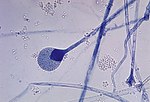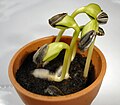Search results
There is a page named "Sporangiophore" on Wikipedia
- on "sporangiophore", but its sister project Wiktionary does: Read the Wiktionary entry "sporangiophore" You can also: Search for Sporangiophore in Wikipedia...334 bytes (0 words) - 01:15, 14 December 2021
- Mitosporangia are carried by specialized hyphae, the mitosporangiophores (sporangiophores). These specialized hyphae usually show negative gravitropism and positive...29 KB (3,400 words) - 14:22, 20 May 2024
- species) use asexual reproduction. When erect hyphal sporangiophores are formed, the tip of the sporangiophore swells to form a globose sporangium that contains...4 KB (433 words) - 16:55, 26 October 2023
- The sporangium forms on the sporangiophore and contains haploid nuclei and cytoplasm. Spores are formed in the sporangiophore by encasing each haploid nucleus...9 KB (899 words) - 15:12, 26 April 2024
- (multi-perforate septa are present only in sporangiophores and gametangia). The hyphae grow mostly within the substrate. Sporangiophores are upright (simple or ramified)...6 KB (560 words) - 12:03, 19 May 2024
- cells are released. In fungi, a sporangium is produced at the end of a sporangiophore that sheds spores. A fungus that forms zygospores is called a zygomycete...2 KB (195 words) - 03:55, 1 March 2024
- supported by a large apophysate columella atop a long stalk, the sporangiophore. Sporangiophores arise among distinctive, root-like rhizoids. In sexual reproduction...7 KB (631 words) - 01:39, 21 May 2024
- rhizoids, which anchor it to the substrate and unbranched aerial sporangiophores. Sporangiophores of R. stolonifer can be up to 2.5 mm long and about 20 μm in...13 KB (1,333 words) - 08:58, 9 May 2024
- the phylum Zygomycota or subphylum Mucoromycotina. The spore-bearing sporangiophores of Phycomyces are very sensitive to different environmental signals...5 KB (529 words) - 00:38, 11 January 2024
- fruits to produce more spores. The asexual fruiting structure (the sporangiophore) of Pilobolus species is unique. It consists of a transparent stalk...6 KB (660 words) - 22:15, 18 May 2024
- sporangia are called sporophylls, while sporangia-bearing stems are called sporangiophores. Some members of both of the two modern classes of Lycopodiophyta (Lycopodiopsida...8 KB (858 words) - 17:28, 16 January 2024
- which spores are formed and from which the mature spores are released sporangiophore An organ bearing sporangia, e.g. the cones of Equisetum. spore A haploid...343 KB (28,462 words) - 18:11, 24 May 2024
- zygosporangium cracks open and the zygospore inside gives rise to the emerging sporangiophore. In slime molds, germination refers to the emergence of amoeboid cells...29 KB (3,669 words) - 07:13, 23 May 2024
- stages: In stage I, the sporangiophore initially elongates at the apex, but does not rotate. In stage II, the sporangiophore develops a sporangium. In...5 KB (589 words) - 02:49, 8 May 2024
- the tips or edges, where water or dew collects. The sporangia and sporangiophores appear white on the lower surface of the foliage. As for tuber blight...74 KB (7,536 words) - 04:10, 25 March 2024
- slightly aromatic, and will not grow at temperatures of 37 °Celsius. Sporangiophores are unbranched, or rarely sympodially branched. Sporangia are dark...2 KB (206 words) - 06:35, 13 May 2024
- megalocarpus produces phototropic, repeatedly dichotomously branched sporangiophores that terminate in globose, apophysate sporangia. Sporangiospores have...6 KB (571 words) - 22:21, 30 December 2022
- stolon is defined as an occasionally septate hypha, which connects sporangiophores together. Root-like structures called rhizoids may appear on the stolon...16 KB (1,861 words) - 19:59, 7 April 2024
- growing colonies and are characterized by tall, simple, unbranched sporangiophores lacking basal rhizoids, non-apophysate sporangia, and pigmented zygosporangial...25 KB (2,529 words) - 04:30, 10 January 2024
- favors temperatures between 20-22 °C. Tufts of grayish to pale-colored sporangiophores on the underside of leaves easily distinguish the infection from other...11 KB (1,237 words) - 18:01, 9 February 2024
- From sporangium + -phore. sporangiophore (plural sporangiophores) (botany) A receptacle in ferns which bears the sporangia, usually a stalk, but sometimes
- dividing near the stem into a long petioled sporangiophore and a shorter petioled sterile segment. Sporangiophore erect, bi-, tri-, or even quadripinnate













